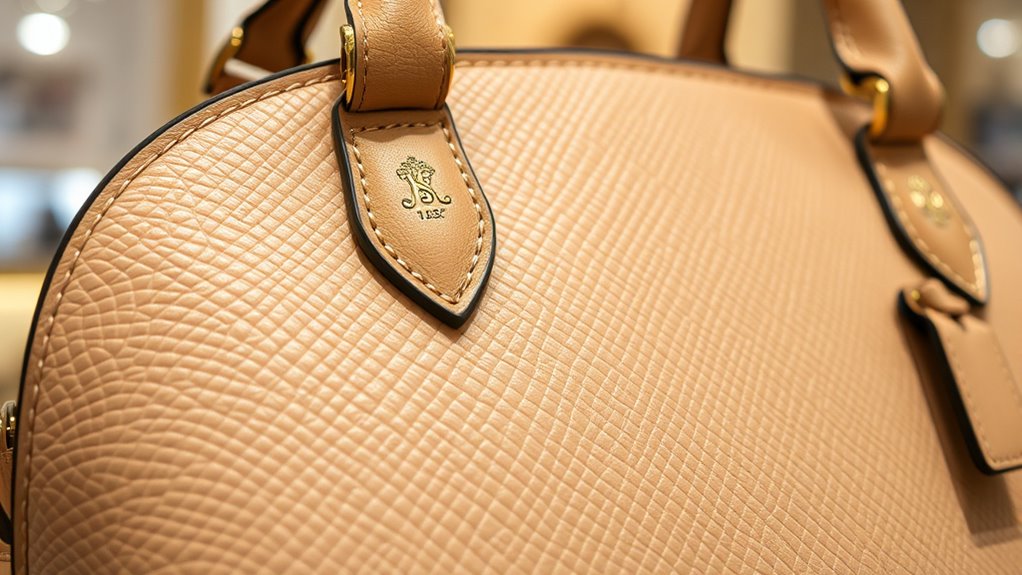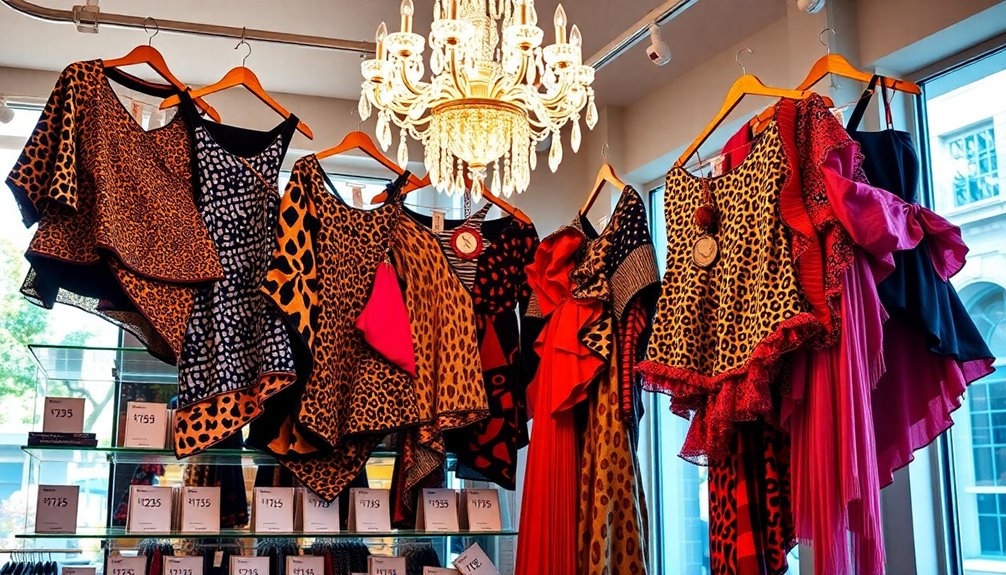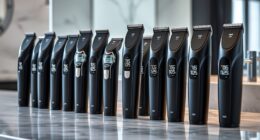To spot authentic luxury items, look at the materials and craftsmanship—high-quality leather, precise stitching, and solid hardware. Check the logos and branding for sharp, consistent details with correct fonts and placement. Examine interior labels and serial numbers for clear printing and matching official formats. Authentic pieces feel sturdy, weighty, and have flawless finishes. Always buy from trusted sources, and if you examine everything carefully, you’ll find signs that reveal their true origin—stay tuned for more details.
Key Takeaways
- Examine the materials, craftsmanship, and finishing details for high-quality, consistent stitching, proper hardware, and refined surfaces.
- Verify logos, branding, and labels for correct placement, font, spelling, and detailed care instructions.
- Check hardware for weight, finish, and precise placement, ensuring it feels solid and produces a resonant sound.
- Inspect stitching for uniformity, tightness, and flawless finish, with attention to interior lining and serial number accuracy.
- Confirm authenticity through official serial numbers, authenticity cards, and detailed craftsmanship markers.
Examine the Materials and Craftsmanship
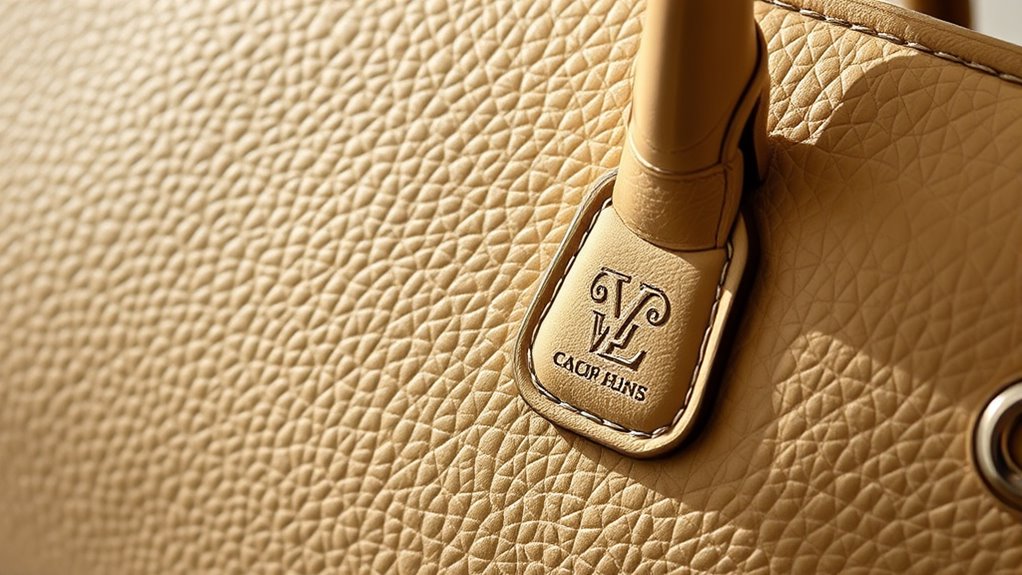
When evaluating luxury items, paying close attention to the materials and craftsmanship can help you distinguish genuine products from fakes. Authentic luxury pieces use high-quality materials like full-grain leather, real gold hardware, and durable fabrics that feel substantial. The craftsmanship is evident in the stitching—uniform, precise, and with consistent tension—often reinforced with double seams to ensure durability. Look for smooth, even surfaces and patterns that are carefully aligned, reflecting expert manufacturing. Genuine items often have material tags or labels indicating the grade of materials used, such as “calfskin” or “14k gold.” The tactile experience also matters; authentic products tend to have a substantial weight and a smooth, refined finish, contrasting sharply with lightweight, cheap-feeling counterfeits. Additionally, examining the quality control markings or serial numbers can further confirm authenticity, as these are usually meticulously applied in genuine luxury items. Checking for material authenticity through specific tests or certifications can also provide added assurance of genuine quality. Moreover, paying attention to subtle details like logo placement and font consistency can reveal manufacturing precision that counterfeit items often lack.
Inspect the Logo and Branding Details
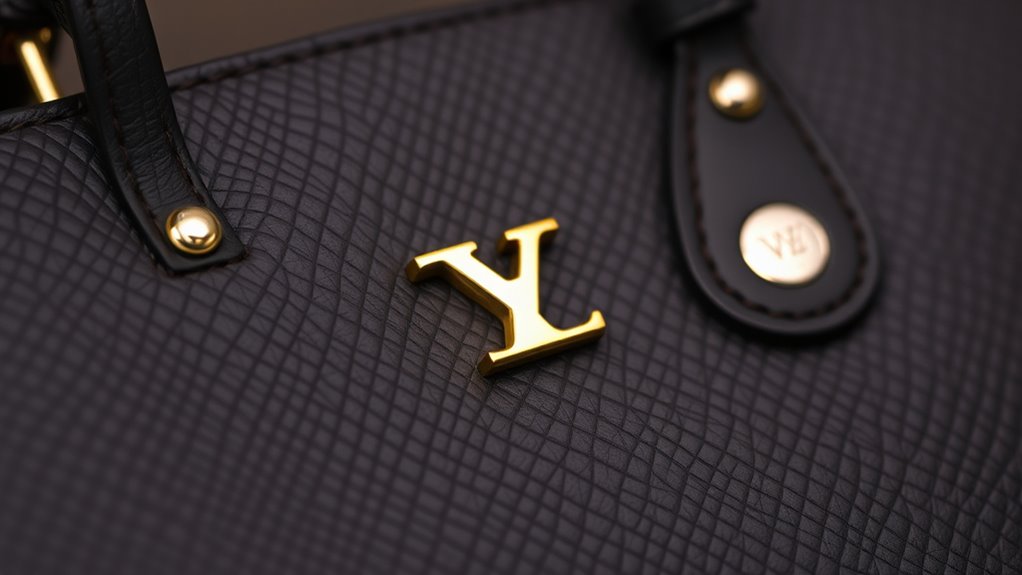
To verify a luxury item’s authenticity, carefully examine the logo and branding details. Authentic brands have precisely designed logos with consistent font, spacing, and placement. Look for sharp, clean edges on embossed, stitched, or engraved logos—counterfeits often appear blurry or poorly executed. Check the spelling, font style, and size; even minor errors can indicate a fake. Authentic branding details match official product images, with logos in correct positions and proportions, avoiding off-center or uneven placement. Additionally, authentic items often come with authenticity cards or certificates that feature logo details aligned with the brand’s standards. Paying close attention to these branding nuances helps guarantee the item’s legitimacy and protects you from counterfeit products.
Evaluate the Hardware Quality and Placement
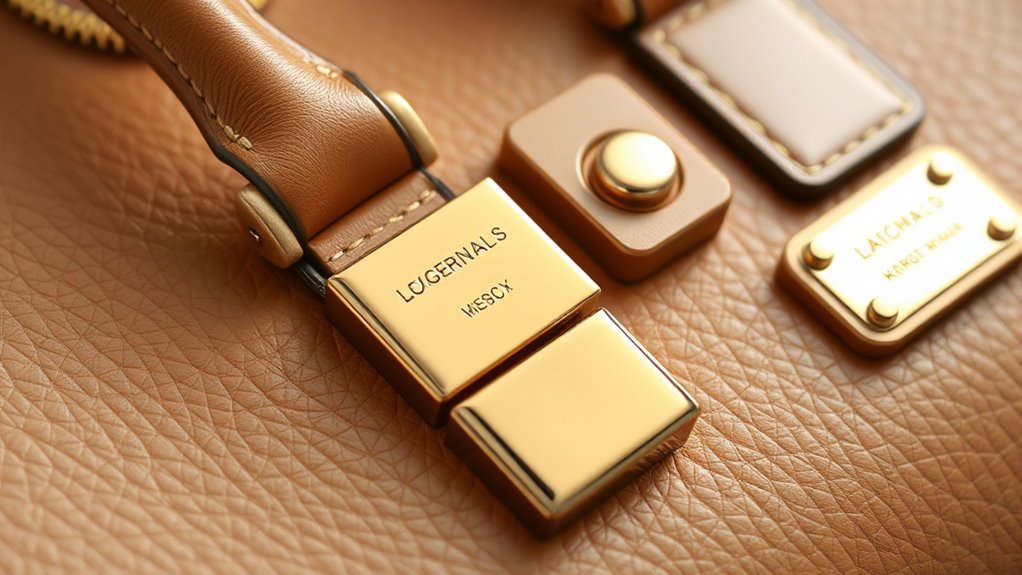
When examining hardware, feel its weight and listen for a solid, metal sound, which indicates quality. Check that the finish is smooth, consistent, and free of chips or discoloration, revealing careful craftsmanship. Also, look closely at the placement—authentic hardware aligns perfectly and is securely attached, with logos and serial numbers cleanly engraved. Additionally, authentic hardware often features high-quality materials, ensuring durability and a premium feel. To further verify authenticity, inspect for consistent craftsmanship, which reflects meticulous manufacturing standards. Recognizing market trends such as the control of a significant portion of supply by new investors can also inform your understanding of luxury brands’ positioning and exclusivity. Incorporating attention to detail and understanding creative practice can help you develop a more discerning eye for genuine luxury items.
Hardware Weight and Sound
Ever notice how authentic luxury hardware feels noticeably heavier and more solid than counterfeit versions? This weight comes from dense, high-quality metals like solid brass or plated gold, signaling genuine craftsmanship. When you tap authentic hardware, it produces a solid, satisfying sound, unlike the hollow or tinny noise of fakes. To help you recognize real hardware, consider this comparison:
| Feature | Authentic Hardware | Counterfeit Hardware |
|---|---|---|
| Weight | Heavy, substantial | Light, flimsy |
| Sound | Solid, resonant | Hollow, dull |
| Placement | Precise, secure | Loose, uneven |
| Finish | Smooth, even, no chips | Scratched, fading |
Assessing weight and sound is essential—genuine hardware confirms the use of quality materials and craftsmanship. The use of industry-standard materials ensures durability and authenticity. Additionally, authentic hardware often exhibits consistent metal finish that resists tarnishing over time. Material consistency is a key indicator of quality, as it reflects careful manufacturing processes and adherence to industry standards.
Hardware Consistency and Finish
Authentic luxury hardware exhibits impeccable consistency in both quality and placement, reflecting the meticulous craftsmanship behind genuine designer pieces. The hardware, often made from dense metals like solid brass, gold, or silver, feels substantial and well-crafted. The finish on authentic hardware is smooth, evenly coated, and resistant to chipping or fading, ensuring a consistent appearance over time. Precise placement is essential; logos, zippers, and clasps align symmetrically and follow the brand’s specific design standards. Counterfeit hardware may feel hollow or lightweight, with dull sounds when tapped. Genuine hardware also features clear, well-engraved logos free of spelling errors or irregularities, confirming the item’s authenticity. Paying close attention to these details helps distinguish authentic luxury items from fakes. Additionally, hardware durability is a key indicator, as authentic pieces are designed to withstand daily use without losing their finish or structural integrity. Recognizing the quality of materials used in hardware can further aid in authenticating the item, as genuine luxury brands select premium metals to ensure longevity and aesthetic appeal. Moreover, authentic hardware often exhibits a consistent weight that reflects its high-quality material composition. Regularly inspecting hardware craftsmanship can reveal subtle signs of authenticity or counterfeit manufacturing techniques.
Check the Stitching for Precision and Consistency
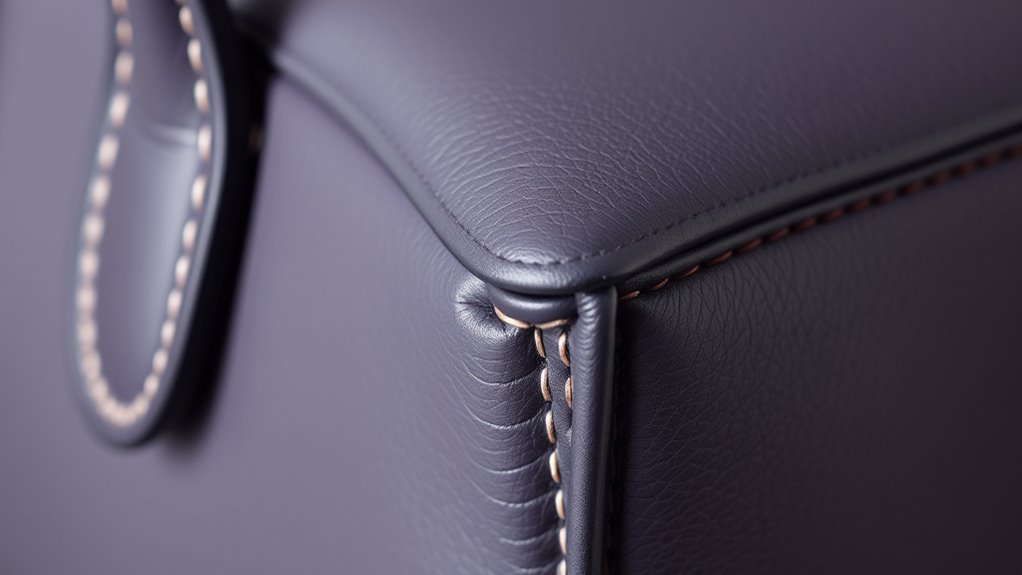
Checking the stitching is essential because it reveals the craftsmanship behind a luxury bag. Authentic items feature uniform, tight stitching with consistent tension and even spacing, showcasing meticulous craftsmanship. Fake bags often have frayed, uneven, or loose stitches, signaling inferior quality. To verify authenticity, look for these signs:
Check stitching for uniformity, tightness, and even spacing to spot authentic craftsmanship.
- Perfectly even stitching that runs smoothly along seams without gaps or puckering.
- Consistent stitch count per inch, matching brand standards and indicating attention to detail.
- Durable stitching resistant to fraying, demonstrating high craftsmanship and long-lasting quality.
- Paying attention to Love and Relationship themes can also help in recognizing genuine branding signatures that often incorporate specific motifs or stylistic elements unique to the brand. Additionally, examining the Glycolic Acid Benefits for Skin can provide insight into the quality of materials used in some luxury accessories, as premium brands often use high-quality components that age well over time. Properly finished stitching not only enhances durability but also contributes to the overall authenticity verification process, ensuring the item maintains its value over time. Consistent quality in stitching also reflects the attention to detail that distinguishes authentic luxury products from counterfeit ones.
Analyze the Interior Lining and Labels
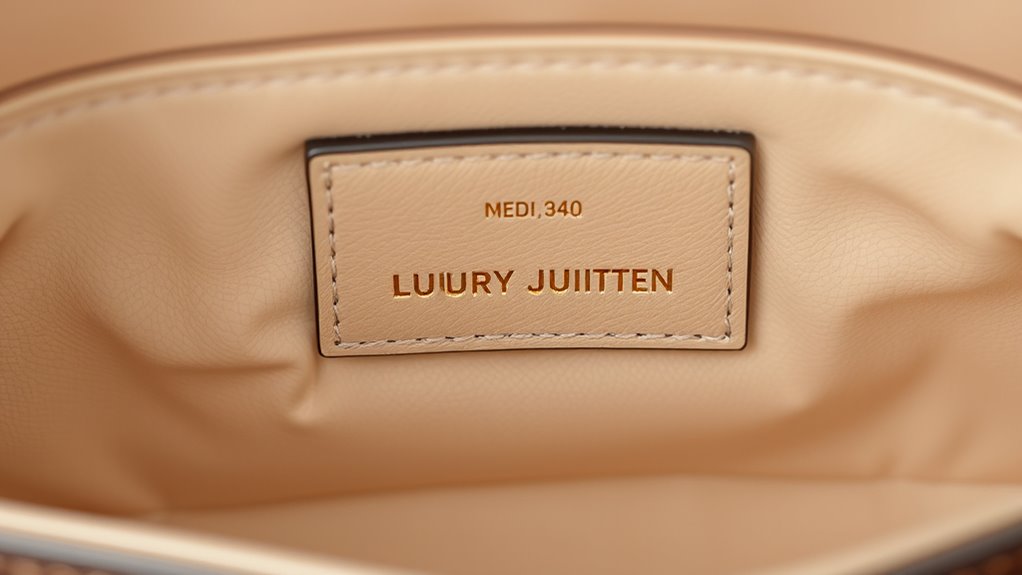
Start by feeling the interior lining; authentic luxury bags use high-quality materials like microsuede or leather that have a consistent texture and weight. Check the labels and tags for precise stitching, clear fonts, and correct spelling, as these details reflect careful craftsmanship. Also, verify any brand-specific stamps or serial numbers to confirm they match official formats and placements. Additionally, examining the brand reputation can help identify genuine items, as trusted brands maintain strict quality control standards. Recognizing authentic craftsmanship in the finishing details can further differentiate real luxury items from counterfeit ones. Paying attention to material consistency across all components is another key aspect of authenticating luxury accessories. Moreover, understanding store hours can be helpful when purchasing from physical locations to ensure authenticity checks are available during your visit.
Material Quality and Feel
The feel and quality of the interior lining and labels can reveal a lot about a bag’s authenticity. Authentic luxury bags use high-quality materials like genuine leather, microsuede, or durable fabrics that feel soft, smooth, and substantial. When inspecting labels, look for authentic labels that are precisely stitched or embossed, with clear, evenly spaced fonts, correct spelling, and consistent branding details. Beware of fake bags with cheap, flimsy linings that feel coarse or papery, often accompanied by uneven or sloppy stitching around labels. Genuine interior labels include detailed care instructions, serial numbers, or authenticity codes matching the brand’s standards. Overall, authentic material quality and craftsmanship showcase meticulous attention to detail, unlike counterfeit items with frayed edges, loose threads, or poorly aligned tags. Additionally, the ingredients to avoid in counterfeit items often include low-quality, potentially harmful materials that compromise both durability and safety. Recognizing luxury craftsmanship involves examining the precision and consistency of stitching and finishing touches, which counterfeit products often lack. Moreover, the integration of AI-based analysis can assist buyers in identifying subtle signs of authenticity through digital tools.
Logo Placement and Font
Have you ever noticed how authentic luxury brands guarantee their logos are perfectly placed and consistently styled? You’ll see that the logo on interior linings and labels is symmetrical, aligned, and proportionate, showcasing meticulous craftsmanship. The font used is precise, matching the official brand typography without misspellings or irregularities—any deviation suggests inauthenticity. Genuine labels are embossed or printed with sharp, clear edges and use high-quality materials that resist peeling or fading. Counterfeit items often have logos with inconsistent font sizes, spacing, or incorrect design details compared to the authentic branding standards. To verify authenticity, compare the logo placement and font style on the interior labels with official images from the brand’s website. Authenticity hinges on these subtle but essential details.
Authenticity Certificates and Tags
Authentic luxury items often include an interior authenticity certificate or tag sewn into the lining, which should match the brand’s specific format and features. Check for serial numbers, authenticity tags, and certificates of authenticity that align with official records.
- Confirm the serial number or barcode matches the brand’s database—this proves the item’s legitimacy.
- Inspect the authenticity tags for textured or embossed logos, not just printed, indicating higher craftsmanship.
- Review the care labels for detailed instructions, material info, and manufacturer details that meet brand standards.
Review the Serial Numbers and Unique Identifiers
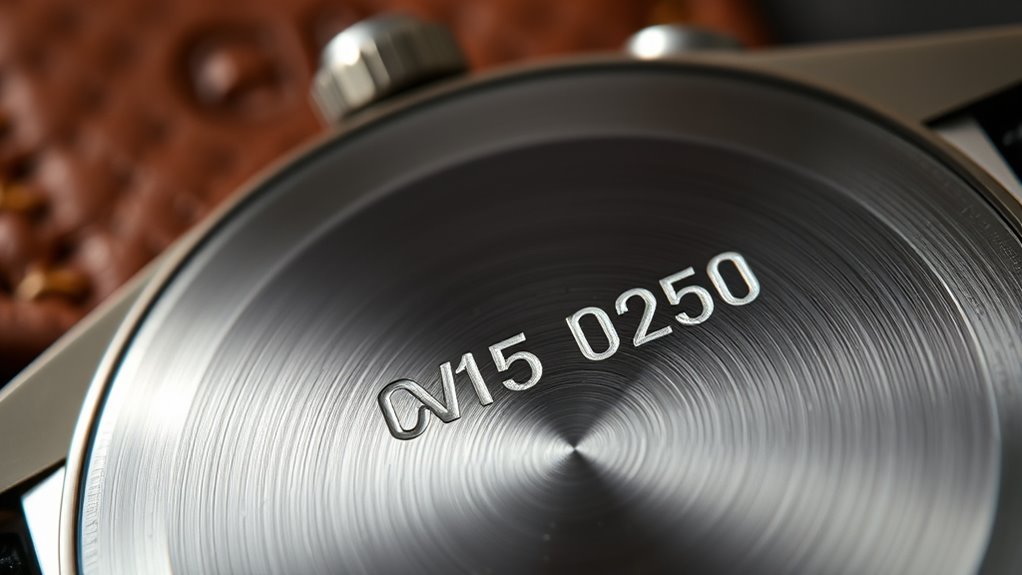
Since serial numbers and unique identifiers are key indicators of authenticity, it’s essential to examine them carefully. Authentic luxury items feature serial numbers, date codes, or identifiers that follow specific formats established by each brand. Check for consistency in font, spacing, and placement, ensuring they align with official brand standards. Genuine serial numbers are typically engraved or embossed clearly, with precise characters that are difficult to alter or replicate. Use reliable authentication guides or brand resources to verify the format matches that of genuine items. Cross-reference the serial number with brand databases or authorized authentication services to confirm authenticity. By paying close attention to these details, you can confidently distinguish genuine luxury items from counterfeits.
Scrutinize the Packaging and Presentation
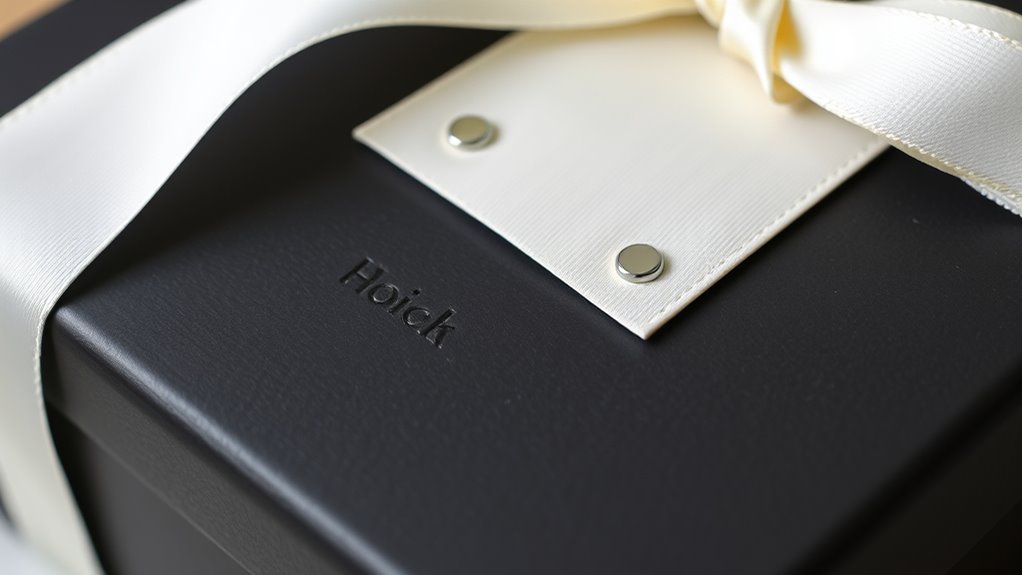
Carefully examining the packaging and presentation can reveal a lot about a luxury item’s authenticity. Genuine products feature high-quality, sturdy packaging with precise branding details. Look for:
- Well-made dust bags that feel soft and durable, often embossed with the brand logo.
- Packaging quality that uses thick cardboard, glossy finishes, and flawless printing—no smudges or misalignments.
- Correct branding details, including logo placement, font, and care instructions, all professionally printed without spelling errors.
Counterfeit packaging tends to be flimsy, lightweight, or poorly printed. Authentic luxury items also include detailed product tags and certificates, all crafted with fine attention to detail. Scrutinizing these elements helps distinguish real from fake.
Look for Spelling and Font Accuracy
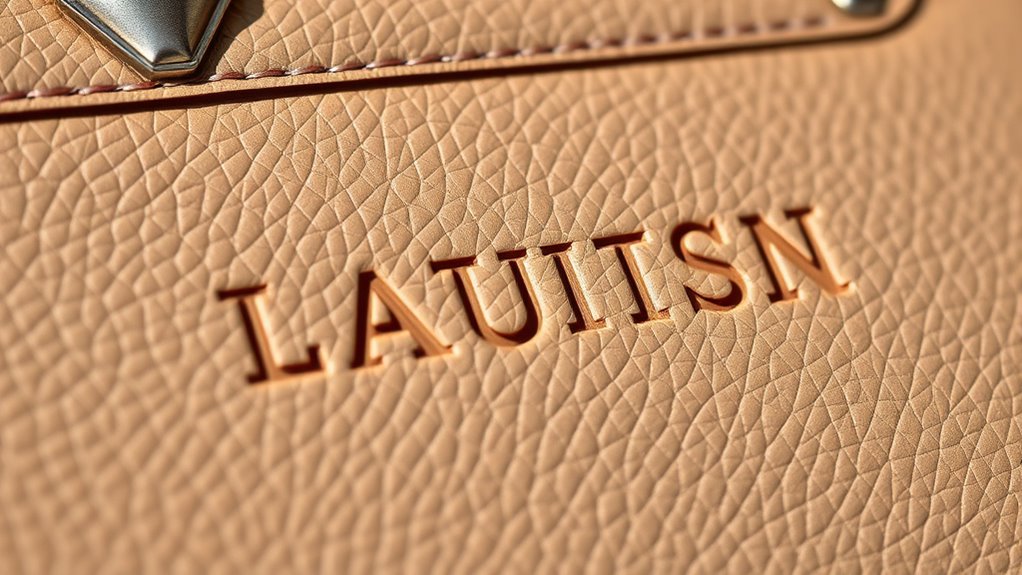
Examining the spelling and font details on luxury items is a crucial step in verifying authenticity. Authentic products feature logos and brand names with perfectly aligned, crisp fonts, avoiding any spelling mistakes or irregularities. Counterfeit items often show misspelled words, incorrect font styles, or inconsistent letter spacing that differ from official branding. Genuine labels use specific font types and sizes that match the brand’s standards, which you can verify through official brand guidelines or authentic examples. Look for clear, evenly printed or embossed text—blurry, crooked, or uneven lettering signals a fake. Always compare the font and spelling details with trusted sources to confirm accuracy, ensuring that every letter, spacing, and font style matches the authentic branding perfectly.
Verify the Presence of Care and Manufacturing Instructions
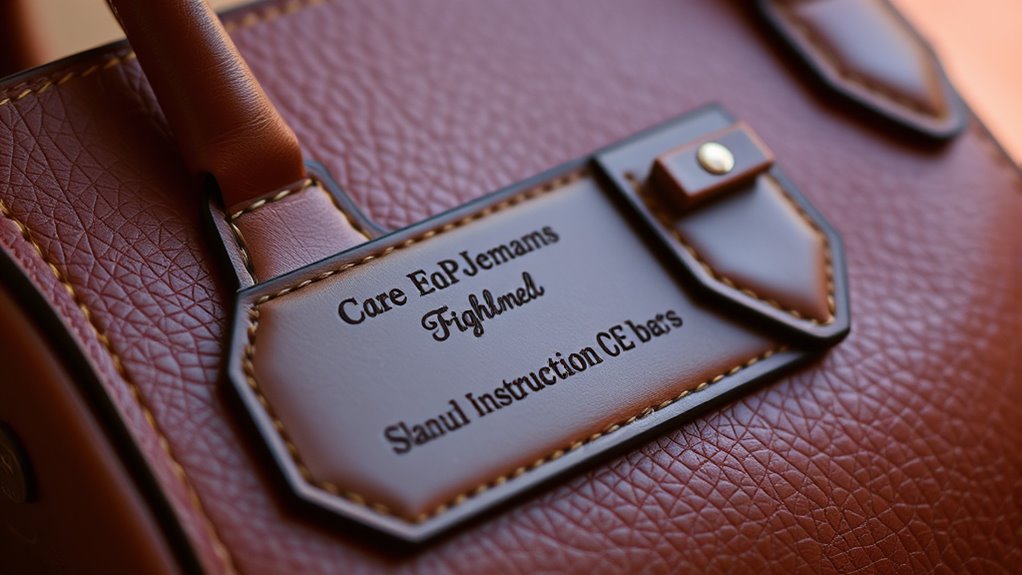
Authentic luxury items typically include detailed care labels and manufacturing instructions sewn into the lining or attached to the product. To verify authenticity, examine these labels closely.
Authentic luxury items always include detailed, well-printed care labels and manufacturing instructions.
- Check the quality of the care labels—genuine items feature crisp, clear print with consistent font and accurate spelling.
- Review the manufacturing instructions—authentic items provide precise guidance on cleaning, materials, and warnings, reflecting craftsmanship and attention to detail.
- Look for completeness—missing or poorly printed care labels and instructions often indicate a counterfeit, as authentic brands prioritize providing this information.
Purchase From Reputable and Authorized Sources
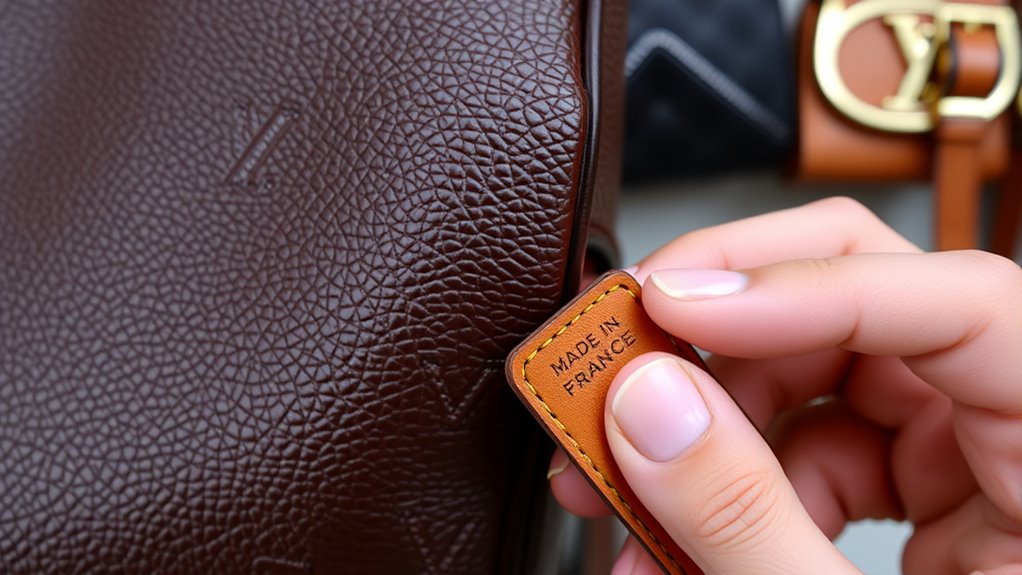
Purchasing luxury items from reputable and authorized sources is essential to guarantee you’re getting an authentic product. Always buy from official brand boutiques, verified retailers, or trusted department stores to ensure authenticity. Check the retailer’s credentials by reviewing customer feedback, brand partnerships, and certification badges that validate their legitimacy. Be cautious of deals that seem too good to be true, especially from unknown sources, as genuine luxury goods rarely sell at steep discounts outside official sales. When buying pre-owned, request official documentation like authenticity certificates, receipts, and serial numbers. If you’re unsure, consider using trusted authentication services or consulting brand experts. These steps help confirm you’re purchasing from a verified retailer and securing a genuine luxury item.
Frequently Asked Questions
How to Spot Fake Luxury Items?
When you’re trying to spot fake luxury items, pay attention to details. Look for inconsistent logos, incorrect fonts, or uneven stitching. Check for serial numbers, certificates, and high-quality hardware. Examine packaging closely—authentic pieces come with sturdy boxes and proper branding. If the price’s too good to be true or the seller isn’t verified, trust your instincts. These signs help you avoid counterfeit luxury goods and confirm you buy genuine items.
How Do You Authenticate Luxury Items?
Your quest to authenticate luxury items might feel like searching for a needle in a haystack, but it’s manageable. Use AI tools like Entrupy to scan items quickly, compare logos, serial numbers, and hardware details for inconsistencies, and examine craftsmanship closely—stitching, materials, and hardware. Check authenticity tags, packaging, and official certificates. When unsure, consult reputable experts to guarantee your luxury treasures are genuine and worth every penny.
How Do You Identify Luxury Goods?
When you identify luxury goods, start by examining the logo placement—look for precise, consistent fonts and flawless alignment. Feel the materials; authentic items use high-quality leather, metals, and fabrics. Check for serial numbers or holograms that match brand standards. Inspect the stitching—tight, even seams show craftsmanship. Finally, assess the packaging; genuine products come with premium boxes, dust bags, and certificates, unlike fakes with cheap or missing extras.
Is There an App to Check Authentic Bags?
Yes, there are apps to check authentic bags. Entrupy is a leading option that uses AI and microscopic imaging to verify luxury handbags with nearly 99.1% accuracy. You just need to follow their simple process of capturing high-quality images of the bag, and the app analyzes it against a database of genuine and counterfeit items. It provides a digital Certificate of Authenticity, giving you confidence in your purchase or sale.
Conclusion
To confirm you’re buying authentic luxury items, always trust your instincts and double-check key details. Did you know that over 70% of counterfeit products are sold through unauthorized sellers? By examining materials, logos, stitching, and packaging carefully, you can confidently spot fakes. Remember, purchasing from reputable sources is your best bet. Stay vigilant, and you’ll enjoy genuine luxury pieces that truly reflect quality and craftsmanship.
